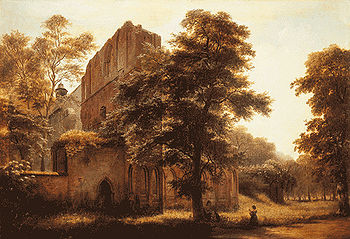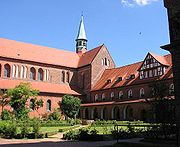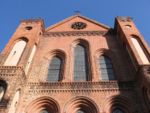
Lehnin Abbey
Encyclopedia



Lehnin
Kloster Lehnin or Lehnin is a municipality in the German state of Brandenburg, about southeast of Brandenburg an der Havel.-Overview:It was established on April 1, 2002 by the merger of 13 villages:...
in Brandenburg
Brandenburg
Brandenburg is one of the sixteen federal-states of Germany. It lies in the east of the country and is one of the new federal states that were re-created in 1990 upon the reunification of the former West Germany and East Germany. The capital is Potsdam...
, Germany
Germany
Germany , officially the Federal Republic of Germany , is a federal parliamentary republic in Europe. The country consists of 16 states while the capital and largest city is Berlin. Germany covers an area of 357,021 km2 and has a largely temperate seasonal climate...
. Since 1911 it has accommodated the Luise-Henrietten-Stift, a Protestant women's community.
History
The abbey was founded in 1180 with the support of Otto I, Margrave of BrandenburgOtto I, Margrave of Brandenburg
Otto I was the second Margrave of Brandenburg, from 1170 until his death.-Life:Otto I was born into the House of Ascania as the eldest son of Albert I , who founded the Margraviate of Brandenburg in 1157, and his wife Sophie von Winzenburg...
as a daughter house of Sittichenbach Abbey
Sittichenbach Abbey
Sittichenbach Abbey , sometimes also known as Sichem Abbey, is a Cistercian monastery in Sittichenbach, now part of Osterhausen near Eisleben in the Mansfeld-Südharz district, Saxony-Anhalt, Germany.-First foundation:...
. In its turn it founded four daughter houses: the abbeys of Paradiz (1236), Mariensee (1258), Chorin (1260) and Himmelpfort (1299).
It was an important contributor to the land development of the Margraviate of Brandenburg
Margraviate of Brandenburg
The Margraviate of Brandenburg was a major principality of the Holy Roman Empire from 1157 to 1806. Also known as the March of Brandenburg , it played a pivotal role in the history of Germany and Central Europe....
. It was dissolved in 1542 during the Reformation.
Since 1911 it has housed the Protestant religious community known as the Luise-Henrietten-Stift.
Buildings
Lehnin Abbey remains significant for its architecture, as one of the finest brick GothicGothic architecture
Gothic architecture is a style of architecture that flourished during the high and late medieval period. It evolved from Romanesque architecture and was succeeded by Renaissance architecture....
structures in Germany
Germany
Germany , officially the Federal Republic of Germany , is a federal parliamentary republic in Europe. The country consists of 16 states while the capital and largest city is Berlin. Germany covers an area of 357,021 km2 and has a largely temperate seasonal climate...
. The ruins were extremely well restored in the 1870s.
Vaticinium Lehninense
The Vaticinium Lehninense was a work, famous in its day, which purported to be the creation of a monk of Lehnin called Hermann, supposedly written in the 13th or 14th century. Manuscripts of the "prophecy", which was first printed in 1722, existed in BerlinBerlin
Berlin is the capital city of Germany and is one of the 16 states of Germany. With a population of 3.45 million people, Berlin is Germany's largest city. It is the second most populous city proper and the seventh most populous urban area in the European Union...
, Dresden
Dresden
Dresden is the capital city of the Free State of Saxony in Germany. It is situated in a valley on the River Elbe, near the Czech border. The Dresden conurbation is part of the Saxon Triangle metropolitan area....
, Breslau and Göttingen
Göttingen
Göttingen is a university town in Lower Saxony, Germany. It is the capital of the district of Göttingen. The Leine river runs through the town. In 2006 the population was 129,686.-General information:...
.
It begins by lamenting the end of the Ascanian
Ascanian
The House of Ascania was a dynasty of German rulers. It was also known as the House of Anhalt, after Anhalt, its longest-held possession.The Ascanians are named after Ascania Castle, which is located near and named after Aschersleben...
line of the Margraves of Brandenburg, with the death of Henry the Younger in 1320, and gives a faithful portrait of several of the margraves, until it comes to deal with Frederick William, Elector of Brandenburg
Frederick William, Elector of Brandenburg
|align=right|Frederick William was Elector of Brandenburg and Duke of Prussia – and thus ruler of Brandenburg-Prussia – from 1640 until his death. A member of the House of Hohenzollern, he is popularly known as the "Great Elector" because of his military and political prowess...
(d. 1688). Here the writer leaves the region of safety and ceases to make any realistic portrait of the people about whom he is prophesying. The work ends with a Catholic ruler who re-establishes Lehnin as a monastery and is also made to restore the union of the Holy Roman Empire
Holy Roman Empire
The Holy Roman Empire was a realm that existed from 962 to 1806 in Central Europe.It was ruled by the Holy Roman Emperor. Its character changed during the Middle Ages and the Early Modern period, when the power of the emperor gradually weakened in favour of the princes...
.
The work is anti-Prussian, but the real author cannot be discovered. The first to unmask the fraud was Pastor Weiss, who proved in his "Vaticinium Germanicum" (Berlin, 1746) that the pseudo-prophecy was really written between 1688 and 1700. Even after the detection of its true character, attempts were made to use it in anti-Prussian polemics.

